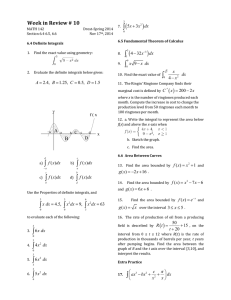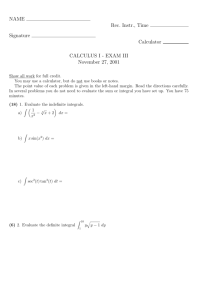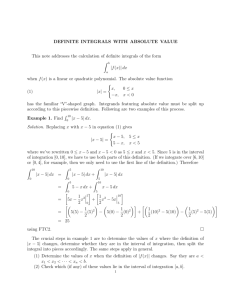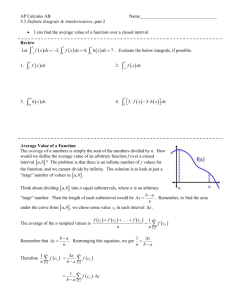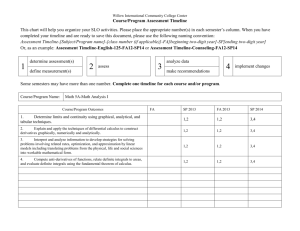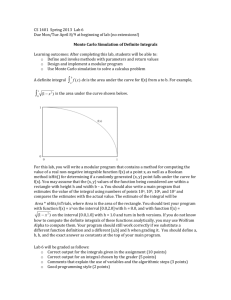Spring 2012 Math 151 Section 6.1
advertisement
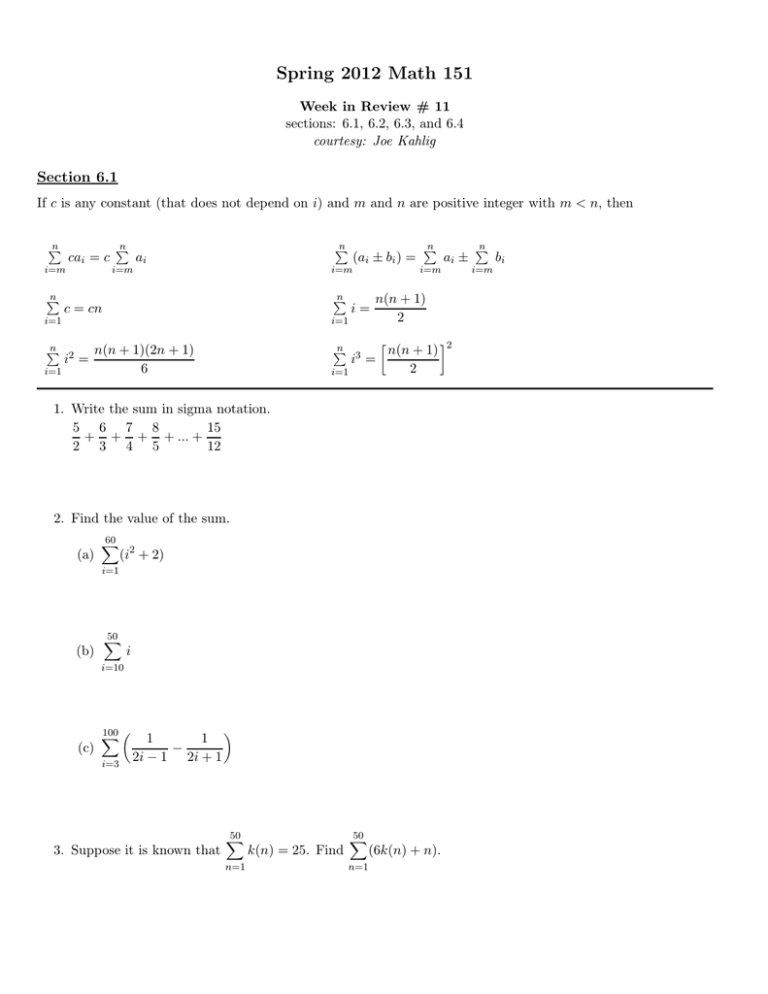
Spring 2012 Math 151
Week in Review # 11
sections: 6.1, 6.2, 6.3, and 6.4
courtesy: Joe Kahlig
Section 6.1
If c is any constant (that does not depend on i) and m and n are positive integer with m < n, then
n
P
cai = c
i=m
n
P
n
P
n
P
ai
i=m
i=m
n
P
c = cn
i=1
i=
i=1
i=1
n
P
(ai ± bi ) =
i2
n(n + 1)(2n + 1)
=
6
n
P
i3
i=1
n
P
i=m
n(n + 1)
2
n(n + 1)
=
2
2
1. Write the sum in sigma notation.
15
5 6 7 8
+ + + + ... +
2 3 4 5
12
2. Find the value of the sum.
(a)
60
X
(i2 + 2)
i=1
(b)
50
X
i
i=10
(c)
100 X
i=3
1
1
−
2i − 1 2i + 1
3. Suppose it is known that
50
X
n=1
k(n) = 25. Find
50
X
(6k(n) + n).
n=1
ai ±
n
P
i=m
bi
Section 6.2
4. Use the function f (x) = x2 + 4 and the partition P = {0, 2, 6, 12, 15} where x∗i is the right endpoint to
answer the following.
(a) Find the norm of the partition.
(b) Sketch the function f and the approximation rectangles.
(c) Find the sum of the approximating rectangles.
Section 6.3
5. Use the midpoint rule with n = 4 to approximate
Z9
ln(x) dx
1
6. Calculate these definite integrals by referring to the graph of f (x). The areas of the regions are indicated
on the graph.
(a)
RA
f (x)
f (x) dx
0
(b)
RC
f (x) dx
A
(c)
RB
7. Use areas to evaluate this definite integrals.
0
10
A
f (x) dx
C
Z4
30
|5x − 8| dx
13
B
C
8. If
ZB
f (x) dx = 12,
A
ZB
A
ZA
h(x) dx = 15 and
B
[2f (x) − 3g(x) + 5h(x)] dx = 150, find
ZB
g(x) dx.
A
9. Express the the definite integral as a limit of a Riemann sum.
Z8 √
x + 5 dx
1
10. Express the following limits as definite integrals.
(a) lim
n→∞
n
X
2
i=1
" 2i
4 1+
n
n
n
X
8
n→∞
n
(b) lim
i=1
1
8+ 3+
3
#
+1
2
8i
n
11. Find values forM and J so that J ≤
and J that are used.
Z2 p
0
x3 + 1 dx ≤ M Be sure to show justification to the choice of M
Section 6.4
12. Use the graph of f ′ (x) and the fact that f (0) = 5 to compute f (3) and f (8)
f ’(x)
3
2
1
−4 −3 −2 −1
2
1
3
4
5
6
7
8
9
−1
−2
−3
13. Find the derivatives of these functions.
(a) g(x) =
Z5
t3
x2
(b) f (x) =
3x+4
Z
t
dt
+1
2
et dt
tan(4x)
14. Compute these integrals.
(a)
Z4
1
(b)
Z5
2
(3x + 1)(x − 1) dx
8x + 3
dx
x2
(c)
Z5
sin(x) + 3ex dx
Z1
6
dx
1 + x2
0
(d)
0
15. The velocity function (in meters per second) for a particle moving along a line is given by
v(t) = t2 − 6t + 8 for 0 ≤ t ≤ 6. Assume that the particle is moving to the right when the velocity is positive.
(a) Find the displacement by the particle during this time interval.
(b) Find the distance traveled by the particle during this time interval.



